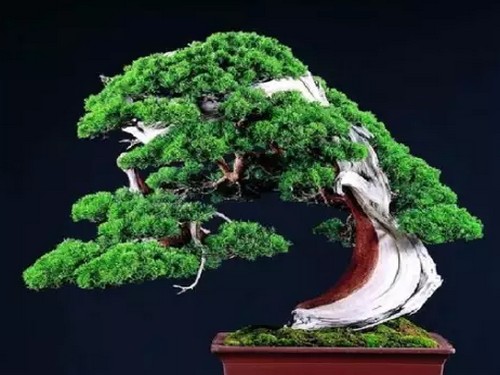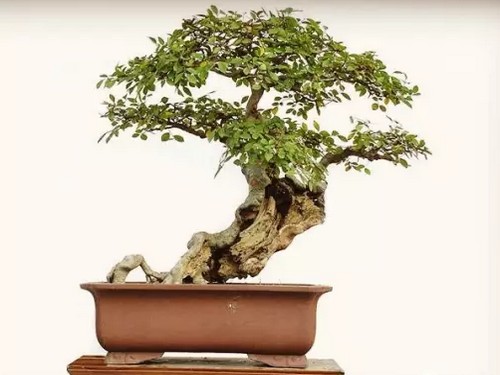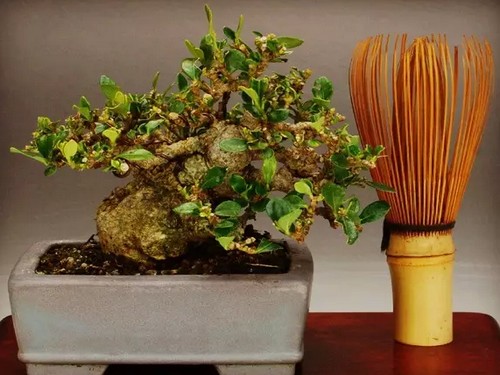Material selection and cultivation of real cypress bonsai
Real cypress bonsai has always been famous in bonsai circles at home and abroad for its old stem, tight leaves and graceful posture, especially in Japanese bonsai exhibitions, which are made of century-old cypress, with white bones and red skin, such as swimming dragons, vigorous and simple, with Xianjia style, which can be called the top grade of bonsai. Taiwan's potted cypress, in addition to Japanese varieties, Tian Pei is also suitable to be cultivated into a potted plant. It is generally known as Taiwan's true cypress, with a lump-like structure, emerald-green color, and rich xylem oil. Red lattice is comparable to the Japanese mountain-picked Yukawa cypress, which is very strong and durable, and is an excellent variety after.

[mountain picking cypress]
More than a decade ago, many were collected in the heyday of mountain harvesting, but the survival rate of mountain-harvested varieties was very low. After an in-depth exploration of the reasons, we learned that it was because the climate was smooth (climate has become a proper term for botany, meaning that after plants were transplanted from alpine native land to flat land, its seeds propagated for several generations and gradually adapted to the climate of the transplant site. If the climate difference is too great, it is still impossible to survive in Hue. ).
The native Sabina vulgaris belongs to the alpine plant, which has a large temperature difference between day and night, four distinct seasons and a long hibernation time. The temperature difference between day and night in the flatland is small, and there is almost no hibernating period. therefore, when this alpine native cypress is transplanted to the flatland, due to the difference in climate between the alpine and the flatland, it is not easy for these cypresses to survive, and only a few can survive. Every Platycladus orientalis is a real plant. in the study of plant science, the probability of gene mutation of seedlings is high, almost one plant and one variety, so the leaf shape and leaf color of each plant are different. Most of the leaves of Sabina vulgaris are slightly flat and dark green in color.
[Tian Pei Zhenbai]
Tian Pei Zhenbai in Taiwan has verified with Mr. Wu Sanlang, the boss of the real cypress, that it was first propagated by cuttings of five old cypresses more than one foot in diameter in the nursery of Yangmingshan more than 40 years ago, and then used as a flower arrangement. Later, it was found that the leaves are good in nature and suitable for cultivation into potted plants. There is no subsequent textual research on whether these five real cypresses are native or exotic species. Tian Pei is generally known as Taiwan cypress, with a strong clump-like structure, emerald green color and rich oil in xylem. Red lattice is comparable to Yukawa cypress in Japan, which is very sturdy and durable, and is an excellent variety. The Japanese mistakenly believe that Taiwan's Zhenbai Yintianpei has been in Taiwan for decades, and that Shili cannot be strong and lasting. Therefore, it is a pity to abandon it.
[artificial propagation] Sabina vulgaris is usually propagated by cuttings or conditioners. The best cuttings are annual twigs, the ear is 10-15 cm long, cut off the twigs below the middle, and insert 1B2 deep; the seedbed is mixed with rotten soil and sand, which is fertile, loose and well drained. Soak through the water after insertion, build a shed to cover it at once, and take root after 2-3 months. In the spring of the following year, separate transplants were carried out to cultivate large seedlings. The true cypress often grows on the creeping ground, and adventitious roots occur, so it can also be propagated under conditions. Grafting propagation with flat cypress or Sabina vulgaris seedlings as rootstock is also easy to survive.
Time: 2019-06-02 Click:
- Prev

Selection and cultivation of bonsai of Ulmus pumila
Hammer elm is small leaf elm, but not elm, its shape is more elegant, the biggest feature is bark and trunk mottled, autumn leaves will change color, belong to deciduous trees, casually very easy to raise, but not very suitable for beginners! Its horticultural varieties are full of diseases and insect pests, but it doesn't stop people from liking it.
- Next

Gardenia bonsai is based on cultivation.
Gardenia jasminoides has bright green leaves, evergreen seasons, large white flowers, fragrant fragrance, shade resistance and toxic gas resistance, so it is a good material for greening, beautification and fragrance. It can be planted in clusters or arranged on forest edges, courtyards, corners and roadsides, and it is also very suitable to be planted as flower hedges.
Related
- Fuxing push coffee new agricultural production and marketing class: lack of small-scale processing plants
- Jujube rice field leisure farm deep ploughing Yilan for five years to create a space for organic food and play
- Nongyu Farm-A trial of organic papaya for brave women with advanced technology
- Four points for attention in the prevention and control of diseases and insect pests of edible fungi
- How to add nutrient solution to Edible Fungi
- Is there any good way to control edible fungus mites?
- Open Inoculation Technology of Edible Fungi
- Is there any clever way to use fertilizer for edible fungus in winter?
- What agents are used to kill the pathogens of edible fungi in the mushroom shed?
- Rapid drying of Edible Fungi

